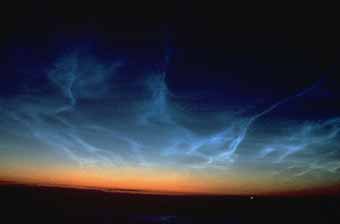 |
| Nightime
noctilucent clouds. |
|
The Earth's atmosphere knows no true boundary.
Even at the orbit of the Space Shuttle, there is still quite
a lot of air there. Satellites can easily detect our atmosphere
out to 10,000 kilometers from the Earth's surface. The outer
atmosphere actually occupies the same region of space as the
plasmasphere, the ring current and the Van Allen belts themselves.
A Complex System
The Earth's atmosphere is far more
complex than a simple onion-layered picture would suggest.
These layers exchange gas and energy all the way out into
the depths of the invisible magnetosphere, and deep into the
atmosphere. One of the most interesting of these atmospheric
layers is the ionosphere: a layer of charged particles surrounding
the Earth at an altitude of about 100 kilometers.
Relaying Communications
No sooner had Marconi invented
the wireless radio in 1909, than scientists used this to prove
that there must be a charged layer of gases several hundred
miles above the Earth's surface. This was the ionosphere.
By 1931, it was also discovered that the charged layer could
be upset by solar flares, causing radio blackouts across the
globe. The ionosphere was the workhorse of communication technology
for most of the 20th century, until satellite communications
offered another means of relaying radio signals from place
to place across the globe.
Just as a mirror reflects light, a cloud of
charged particles can reflect longer-wavelength radio waves.
The denser the cloud, the higher the frequency of the wave
that can be reflected. In the ionosphere there are typically
5 charged particles per cubic centimeter, so this means that
radio frequencies in the AM radio band are easily reflected,
but it also means that the much higher frequency FM signals
pass through it very easily. TV signals are at such high frequencies
that the ionosphere is completely transparent. As a system,
the ionosphere is electrically connected to the ground through
the tops of thunder storm clouds, and it is connected to the
rest of the magnetosphere through the magnetic lines of force
and currents that flow along them.
The ionosphere is a lumpy, cloudy layer,
and radio signals actually 'twinkle' like stars because of
the changing transparency and location of these cloudlets,
in a phenomenon called radio scintillation. Meteors that disintegrate
near these layers also add their charged gases to this layer.
Radio amateurs and the military alike use these meteor trails
to reflect radio signals at very high frequencies; much higher
than what the ionosphere can naturally reflect.
Noctilucent Clouds
Also in this layer, or near its
base, we can occasionally see very high altitude clouds forming,
which can be seen well after sunset. They are called noctilucent
clouds and scientists still don't know how they form or why.
Their appearance seems to have something to do with the level
of solar activity.
 Find
out more about the Sun-Earth Connection at the Sun-Earth
Connection Education Forum Web site.
Find
out more about the Sun-Earth Connection at the Sun-Earth
Connection Education Forum Web site.
Text adapted from the
Sun-Earth Connection Tutorial courtesy of NASA, originally
written by Dr. Sten Odenwald. Images and videos courtesy of
NASA unless otherwised noted.
|